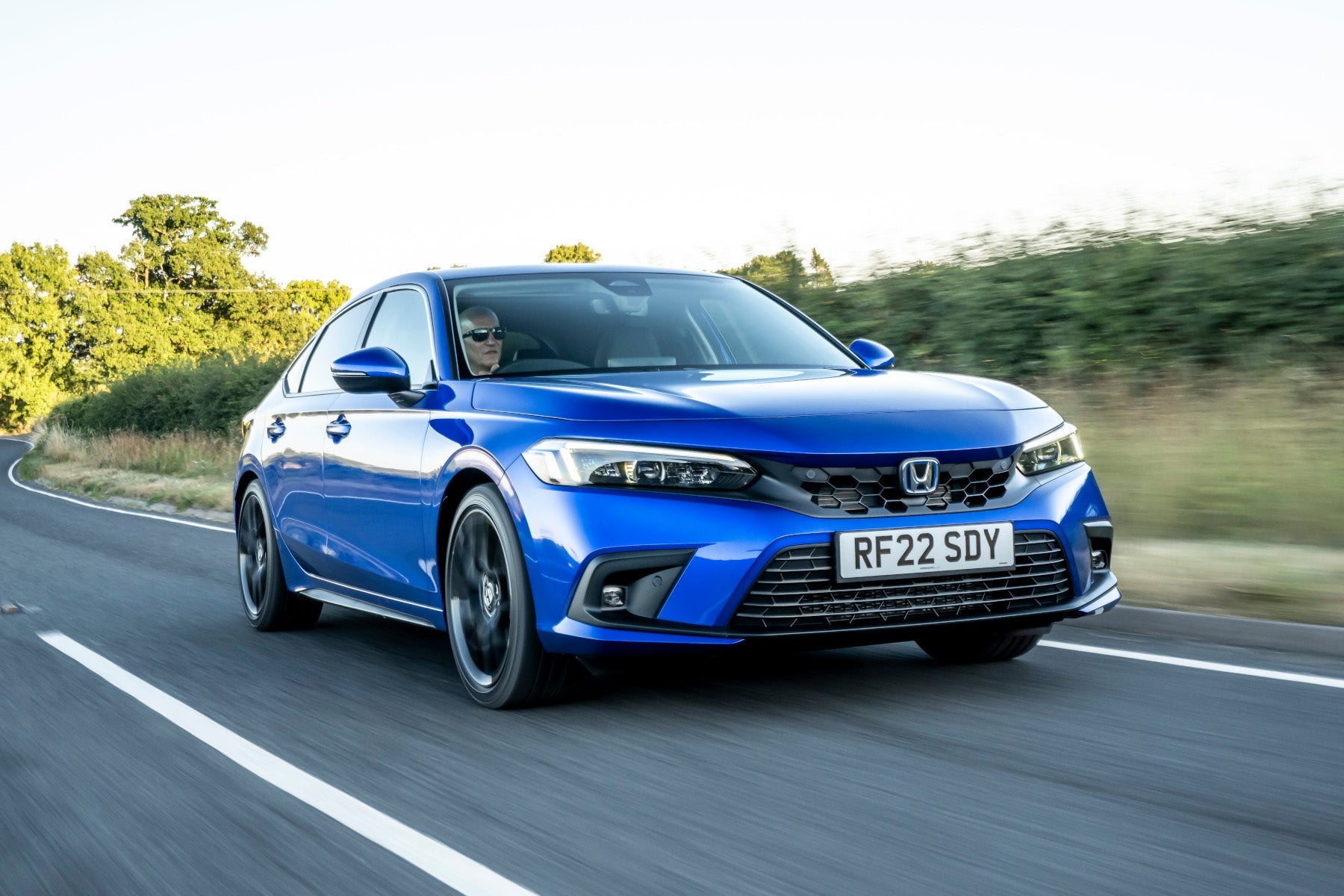Honda Civic Review 2025: Price, specs & boot space
Written by Lawrence Allan
Quick overview
Pros
- Smart and spacious cabin
- Very well-sorted ride and handling
- Hybrid system is Honda's best yet
Cons
- Only offered with single hybrid powertrain option
- Entry price point is higher than most rivals
- Not the most exciting design
Verdict: Is the Honda Civic a good car?
"The latest Honda Civic might not look like a radical departure from the old one, but much has changed including a classier, more user-friendly interior, smooth and efficient hybrid-only power and better ride and handling. The starting price is much higher than before, but our 2025 Honda Civic Review shows you get what you pay for."
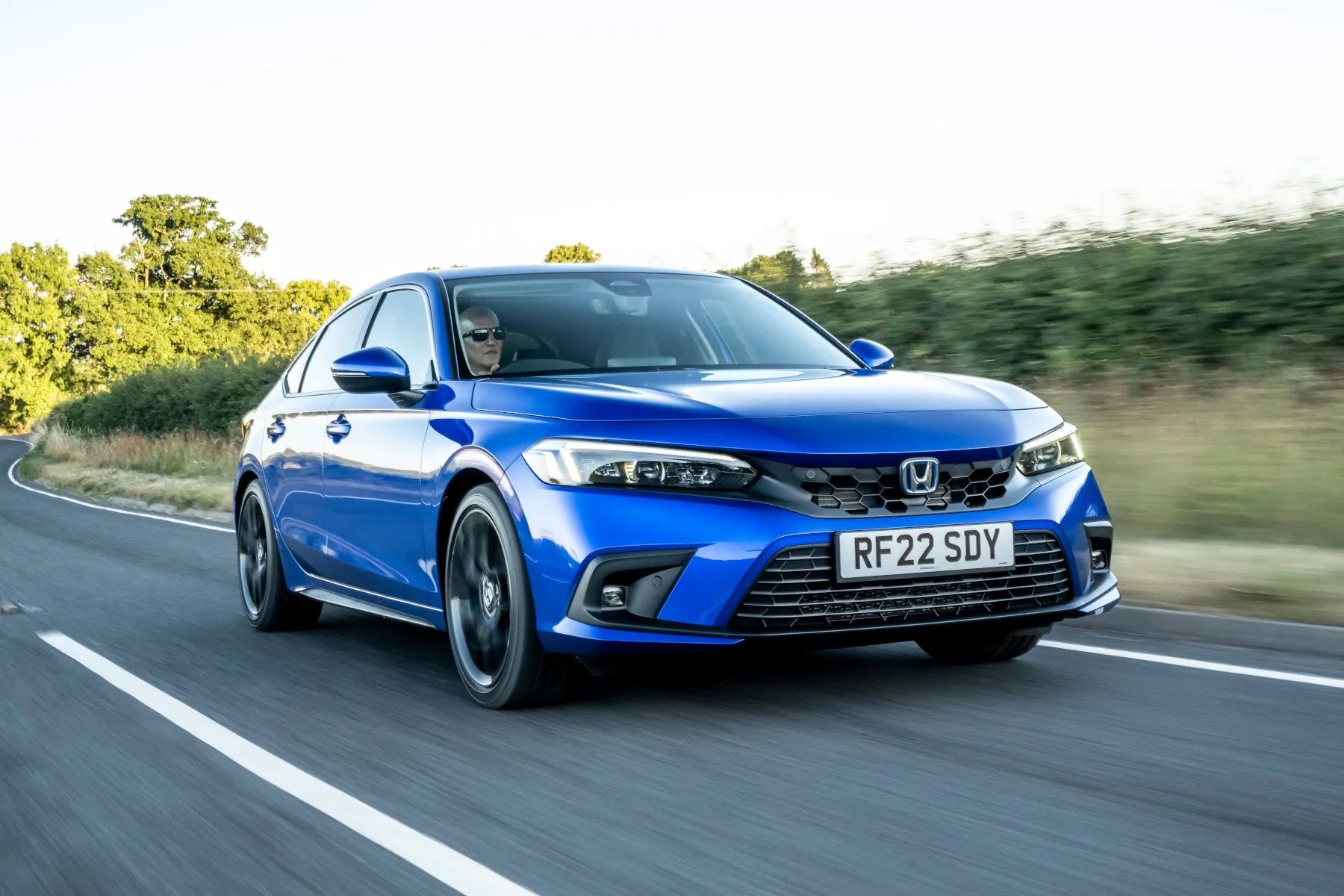
Like when Vauxhall launches a new Astra and Volkswagen reveals a new Golf, a new Honda Civic arriving on the scene is a big deal. However, you might look at the latest, eleventh-generation Civic and think that not all that much has changed.
Part of that is the design, which isn't a dramatic departure from the old Honda Civic. As a hatchback, it's smart and neatly proportioned, and a bit less divisive than the old car, while colour choices like the nice blue in our pictures help it avoid looking dull. But it's not exactly showy or striking, is it? Previous Civics divided opinion but changed dramatically between generations.
In other markets such as the U.S., this Civic is offered with a variety of engine choices, including a 200PS 'Si' model. Here, however, there's only one mainstream choice - outside of the bonkers Honda Civic Type R hot hatch, which we've reviewed separately - and it's a self-charging hybrid mated to a sort-of CVT gearbox (it doesn't actually have a traditional gearbox, but it works in a similar way as a CVT).
Sounds boring? Well, Honda has worked hard to make this Civic as engaging as possible to drive, with lots of technical upgrades over the old car. The result is an efficient hybrid that's actually quite enjoyable on the road, with good performance, a transmission that does a decent impression of a traditional automatic, and improved refinement over other Honda hybrids such as the HR-V.
What's more, the Civic is as capable in the bends as it is in a straight line, with keen steering, sorted handling and loads of grip. Granted, a Ford Focus is still more fun, but the Honda still impresses and balances that with a firm yet composed and refined ride.
Inside, too, it's an improved Honda, largely because the firm's really outdated old infotainment has been ditched for smarter, more responsive (but still not class-leading) tech. But there's also a smarter design and classier materials that help the Honda go some way to competing with posher rivals such as the Audi A3.
The old Civic was already one of the most spacious cars in its class, and this larger-than-ever Civic still excels. It's clear that Honda wanted to make sure nobody missed the old Accord, so you get a big boot and plenty of space in the cabin, although the sloping roof means those after more headroom would be better off with the bigger CR-V SUV.
Yes, it might be far from the cheapest family hatchback around - certainly a Skoda Octavia is better value for money - but you get a strong level of standard equipment, that hybrid power and Honda's strong reputation for reliability and quality. All in, the new Civic is a very strong contender in the family car class.
Looking for a used car for sale? We've got 100s of Honda Approved Used Cars for Sale for you to choose from, including a wide range of Honda Civic cars for sale. If you're looking for the older version, you need our used Honda Civic (2017-2022) review
Is the Honda Civic right for you?
The new Honda Civic makes a lot of sense for everyone from family buyers who don't want an SUV, commuters who pile on the miles, and folk who just want a nice and dependable new car that'll last as long as they need it. Yet there's also some appeal here for keen drivers that also need good fuel economy.
It's maybe not the most fashion-conscious choice, unlike Honda's HR-V, which is rather stylish. The Civic's more restrained look means it isn't likely to stand out in the car park much, so a Peugeot 308 or Mazda 3 is a better bet for that. Neither of those cars are as practical as the Civic, however, and nor do they offer a smooth full hybrid engine option (the Peugeot is a plug-in hybrid, which can be a mixed bag, and the Mazda only has a mild-hybrid petrol).
What other cars are similar to the Honda Civic?
In many ways the Honda Civic's main competitor is the Toyota Corolla. It's also hybrid-only, although it can be had in a more affordable, lower-powered format, plus Toyota has the same expectation of quality and reliability. It's arguably more striking to look at on the outside than the Civic, but that's countered by a duller interior.
Other key challengers for the new Civic with hybrid options include the Volkswagen Golf, the Vauxhall Astra, the Mercedes A-Class and the Audi A3. There's also the mild-hybrid Ford Focus, the Peugeot 308, the Hyundai i30 and the Kia Ceed to consider, too, with the Korean models undercutting the Honda on price.
Comfort and design: Honda Civic interior
"Like the outside, the Civic's interior isn't dramatic or exciting to look at. But it is smart and fairly sophisticated, with neat touches, a simple and logical design, and good quality materials."
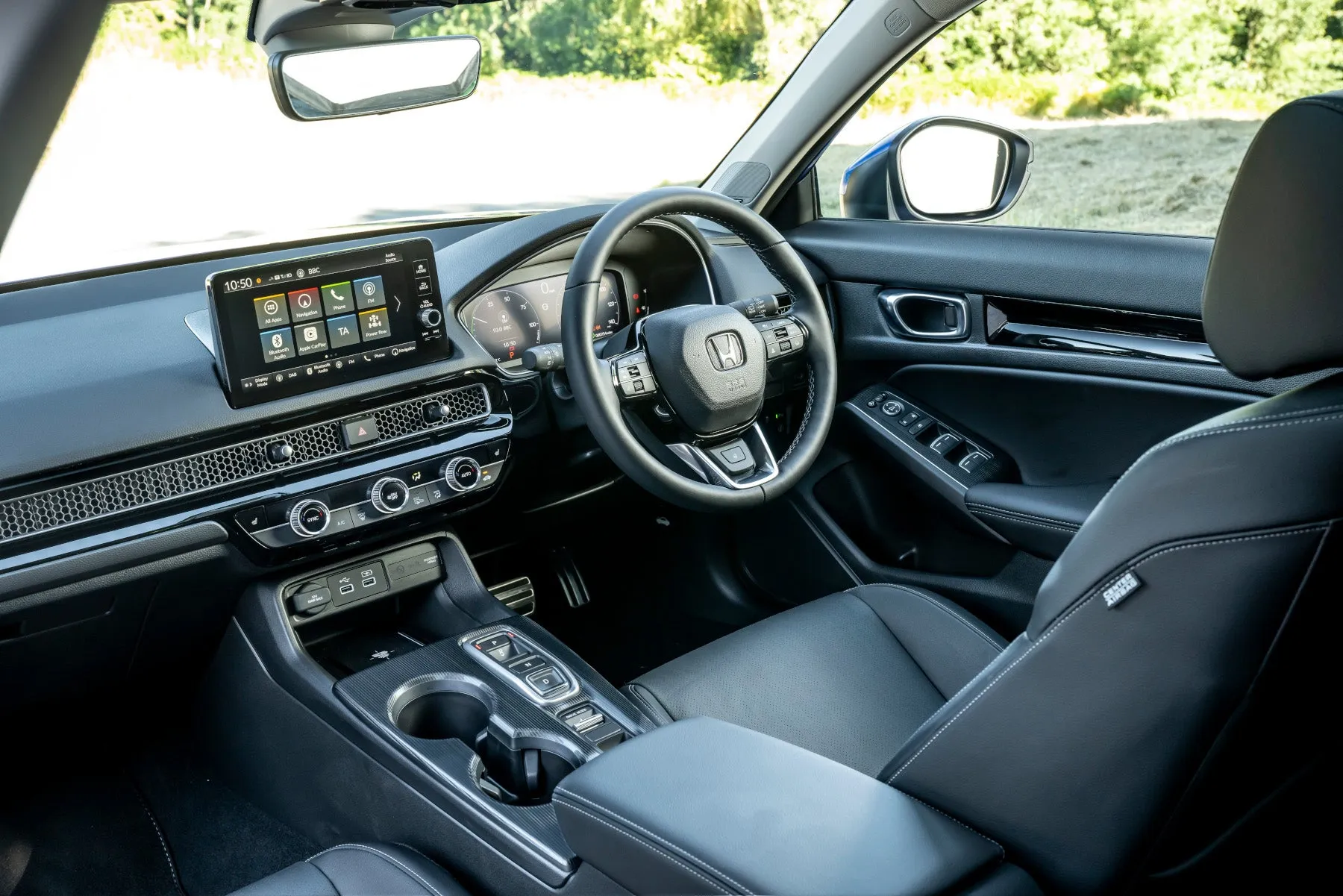
There's lots to like about the interior of the new Civic, even if at first glance it doesn't wow you with a bold design and bright colours. Instead, Honda has gone for a sophisticated, classy design that makes it look and feel more upmarket than a Toyota Corolla or Ford Focus.
It's perhaps a less driver-focused cabin than the old Civic, but there's a definite uplift in the quality feel (as you'd expect given the price increase). We like the simplicity, and the fact that Honda has avoided over-styling the cabin (something older-generation Civics were guilty of), while there are neat details such as the full-width air vent strip running across the dashboard. It's not actually all made up of air vents, but it's a nice touch.
The layout is really simple and logical, too, with lots of physical buttons and knobs, unlike an increasing number of rivals. The touchscreen now sits on its own plinth on top of the dashboard to put it more in the driver's line of sight, with (depending on trim) either part- or fully digital dials in the instrument binnacle. The tech is thankfully much improved over the old Civic, but Honda hasn't forgotten good ergonomics, with simple and solid-feeling switchgear for the climate control stack below.
With plenty of space, storage and equipment, and a quality look and feel, there isn't really anything missing in the Civic to give cause for complaint.
Quality and finish
Honda has always managed a good level of fit and finish, and the new Civic is no different. But where it improves is perceived quality, with nicer soft-touch finishes than models of old. The doors close with a satisfying thunk, most of the touch points feel pretty classy, and the upholstery is of decent quality. It's more Mazda 3 than Ford Focus, which we like.
Honda's put a huge amount of work into the way the switches and knobs click as you use them. The climate controls give you nice feedback, and even the air vent shutter control clicks satisfyingly as you open or close the slats.
Our only complaints surround the lower parts of the centre console, with a centre armrest that wobbles if you provoke it and a questionable bit of trim around the cupholders. Honda says it doesn't show up fingerprints and scratches as much as the usual gloss black trim, and they're right. But it's not a very pleasant texture to touch: something like faux aluminium or wood grain would've been nicer.
Infotainment: Touchscreen, USB, nav and stereo in the Honda Civic
This is where there was real room for improvement over the old Civic. The old car's infotainment screen had dated colours, confusing menus and poor touch responses, making it feel several years behind the best competition. It was, frankly, one of the worst systems on the market. Honda has ditched all that with a completely new setup, similar to that in the latest HR-V.
Although the 9.0-inch display isn't the largest or most dazzling in its class, it's much easier to use than before, with simple menu layouts, sharp graphics and speedy responses. Also, Apple CarPlay and Android Auto are standard across the range if you'd rather bypass most of Honda's system. That means you can mirror apps such as Google Maps or Spotify onto the display, although it's a shame only Apple's integration is wireless here.
While the infotainment can't be controlled via a rotary controller (like in the Mazda 3), there are a few proper shortcut buttons if you get lost and a rather dashing knurled knob for adjusting the volume.
The Civic also has a 10.2-inch digital dial display on top-spec trim, which is smart but not ultimately as customisable as the VW Group's system. Lesser versions get a smaller instrument display flanked by some analogue dials, which is fine. We like that Honda has avoided touch-sensitive buttons on the steering wheel, too.
The standard stereo in the Civic gets eight speakers and sounds pretty good, but if you plump for the Advance trim you'll get a punchy twelve-speaker BOSE sound system that enhances your favourite tunes. You also get USB ports and a 12V socket below the climate dials, plus a wireless phone charging pad on top trims.
Space and practicality: Honda Civic boot space
The old Honda Civic was a big car - one of the largest in its class, in fact - and the new model doesn't grow massively in size. It didn't need to, but there are some gains anyway.
In terms of exterior dimensions, the new Honda Civic hatchback is 4549mm long, 1414mm tall and 1800mm wide. That makes it 30mm longer than the old car, yet it's virtually the same width and has a lower roofline. Only the Skoda Octavia is larger in this sector.
Honda has increased the wheelbase by 35mm over the old car, which was hardly cramped to begin with. The result is a comfortable place to sit in the rear for two adults, and three for short journeys, although those well over six foot will have their comfort impaired slightly by limited headroom. There seems to be more glass around the back seats than in the old car, which makes it feel less claustrophobic, but you can't fully slide your feet under the front seats because they sit quite low.
There will be no complaints from those in the front seats, however. With those seats able to sit fairly low for a front-wheel drive hatch, there's a nice driving position, with plenty of adjustment in the seats and steering wheel. Storage is okay but not outstanding, with a pretty small glovebox, reasonably sized door bins, and cupholders and a cubby under the centre armrest.
Where the Civic does impress is on boot space. At 409 litres, the capacity is actually smaller than the old Civic's, but most of that is because the hybrid's battery is positioned under the boot floor. Even allowing for that, it's still very competitive, beating almost all its rivals for space bar the gigantic Skoda Octavia. Advance models lose five litres of space because of the BOSE sound system's subwoofer, but that'll hardly make a difference.
The tailgate has a wide opening, but the seat folding is unremarkable with a 60/40 split and no ability to fold the seats via boot-mounted levers. However there is one clever touch: the parcel shelf is actually a piece of tough fabric that comes out of the side of the boot and is pulled across. It means that when you don't want it to be there you don't have to find storage for a bulky cover somewhere.
Handling and ride quality: What is the Honda Civic like to drive?
"The latest Honda Civic is hybrid-only, but it's quite a bit more fun to drive than you might think. A Ford Focus is more engaging, but the Honda drives like a premium product."
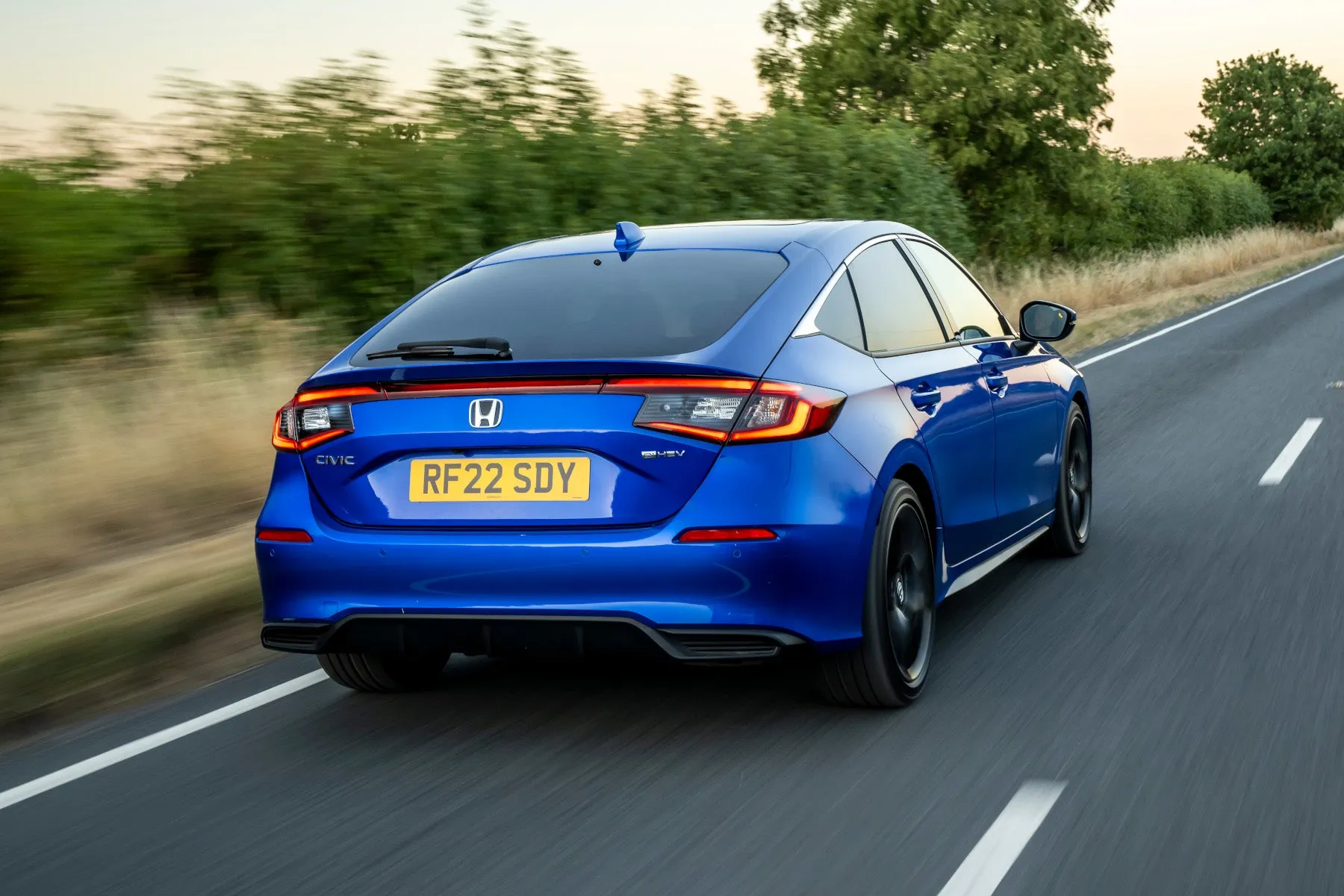
Honda's engineering team talks at great length about how much emphasis has been put on improving the Civic's driving experience for this eleventh-generation model. A lot of that has gone into the hybrid system to make it more engaging, but some of it's also gone into the ride and handling.
The latest Honda Civic has a longer wheelbase and wider rear track than the old car, which boosts stability, while there's also new suspension tuning, a 22% more rigid body and details such as an aluminium bonnet, which reduces weight.
The result is a car that strikes a nice balance between handling composure and ride comfort. The steering is nicely positive, with good weighting and a keen turn in, helping it feel fairly agile. Body roll isn't quite as tightly controlled as with a Ford Focus, but it doesn't wallow around, and there's plenty of grip from the front tyres.
Honda has added a system called Winding Road Detection, which is supposed to sense when you're giving it some on a twisty road and keeps the petrol engine in its optimum bandwidth for acceleration. There's not a dramatic difference, but then the engine is responsive enough anyway.
Sure, it isn't as playful and entertaining as the Ford, and nor can it quite live with the agility of the Mazda 3. But it really isn't far off, and counters with a more comfortable ride than either. The Civic deals with scruffy surfaces better and feels generally more composed, although there is still some road noise to make it a bit less refined than a Volkswagen Golf.
What engines and gearboxes are available in the Honda Civic?
It doesn't seem that long ago that most family hatchbacks were offered with an almost baffling array of engines and gearboxes to choose from. Those days are gone as carmakers prioritise the popular models to reduce costs, and Honda reckons the only Civic that European buyers need - aside from the Type R hot hatch - is the hybrid model.
The raw stats are pretty good, though. With a non-turbo 2.0-litre four-cylinder petrol engine mated to two electric motors and a battery pack, power is put through an electric e-CVT 'gearbox' (not a traditional mechanical one). Honda says they went for this arrangement because it delivers the best of all worlds: the hybrid powertrain is more powerful than the old Civic's 1.5-litre turbo petrol, is more efficient than the 1.0-litre, and has more torque than the diesel.
Unlike some hybrids, which directly power the wheels through both power sources, the Civic's petrol engine is usually only used as a generator to produce electricity, which then drives the motors (and wheels) and charges the battery. At high speeds, the engine will also drive the wheels directly, but not often. The Honda CR-V, HR-V and Jazz also do this, and none of them are particularly fun to drive.
There are some key differences with the Civic, however. The first is that the 2.0-litre engine here is now direct-injection (making it more responsive and efficient) and the second is the new generation 'e-CVT' 'gearbox' that's been worked on to feel more like a regular automatic. Again, Honda is at pains to point out that it isn't actually a gearbox at all, but it feels like one in practice, and if you try and explain how it works at dinner parties, people will get up and leave.
Like all full hybrids, it'll pootle around in electric mode for short distances around town, and be kept in that mode up until about 30mph. Press the throttle harder and the engine kicks into life, but does so quietly and smoothly. You can also press the throttle further before the motor starts revving up than in the HR-V and Toyota Corolla.
Ask for full power and it's a fairly brisk performer, with 184PS and 315Nm of torque resulting in a 0-62mph time of 7.8 seconds. The engine revs do rise as you accelerate, but it's not a particularly intrusive noise, and Honda has added simulated stepped 'gears' to reduce the constant maximum-rev thrashing that other CVT hybrids often have. It works really well overall: in fact, it's the best mainstream hybrid transmission we've tried.
If you want more theatre, putting the Civic into Sport mode switches on an active sound generator. Honda says this makes it sound a bit like the revvy old 'VTEC' engines, although we're not totally convinced. You can turn it off in Individual mode, which also lets you play around with the throttle response and steering weight.
You can also use the paddles behind the steering wheel, but not as gear shifters. Instead, they operate the regenerative braking through different stages, a bit like Kia and Hyundai do in their electric cars. This means you can have zero regen for more relaxing motorway drives and switch to more forceful regen' when you're on a twisty road (so it's like engine braking) or around town.
Refinement and noise levels
The new Civic is refined around town, with no engine noise when running in electric mode, and a nicely insulated sound when the petrol unit does kick in.
The traditional problem with CVT hybrids is that the calm is shattered out of town because any meaningful call for acceleration causes the gearbox to send the engine revs soaring, making a lot of noise in the process. Newer hybrids are getting better on this score, and the Civic manages to avoid it almost entirely. You can get up to speed quickly without the engine howling in protest, and even if you do floor it, the revs soar up and then fall again quickly as the gearbox simulates the gears of a normal automatic.
Elsewhere, wind noise is well insulated and there's very little suspension noise to intrude. However, the Civic does seem to transmit more road noise into the cabin than something like a Volkswagen Golf.
Safety equipment: How safe is the Honda Civic?
Honda claims crash protection in the latest Civic is 'class-leading' thanks to eleven airbags as standard and a stiffer body structure. Standard safety kit includes automatic emergency braking with pedestrian and cyclist detection (via a new, more advanced front camera that's even heated so it works well in winter), plus road departure mitigation, an improved lane keeping assist system, traffic sign recognition and intelligent speed assist.
Adaptive cruise control is also standard across the range. It's a system that's been improved over the old car's, and now comes with Traffic Jam Assist for low-speed autonomous driving. All models get auto high beam, but only Advance grade gets adaptive matrix LED headlights.
Euro NCAP awarded the Honda Civic a maximum five stars for safety when it was crash-tested in 2022.
MPG and fuel costs: What does a Honda Civic cost to run?
"The Civic might not be that cheap to buy but it will be cheap to run, with the new hybrid system providing impressive economy."
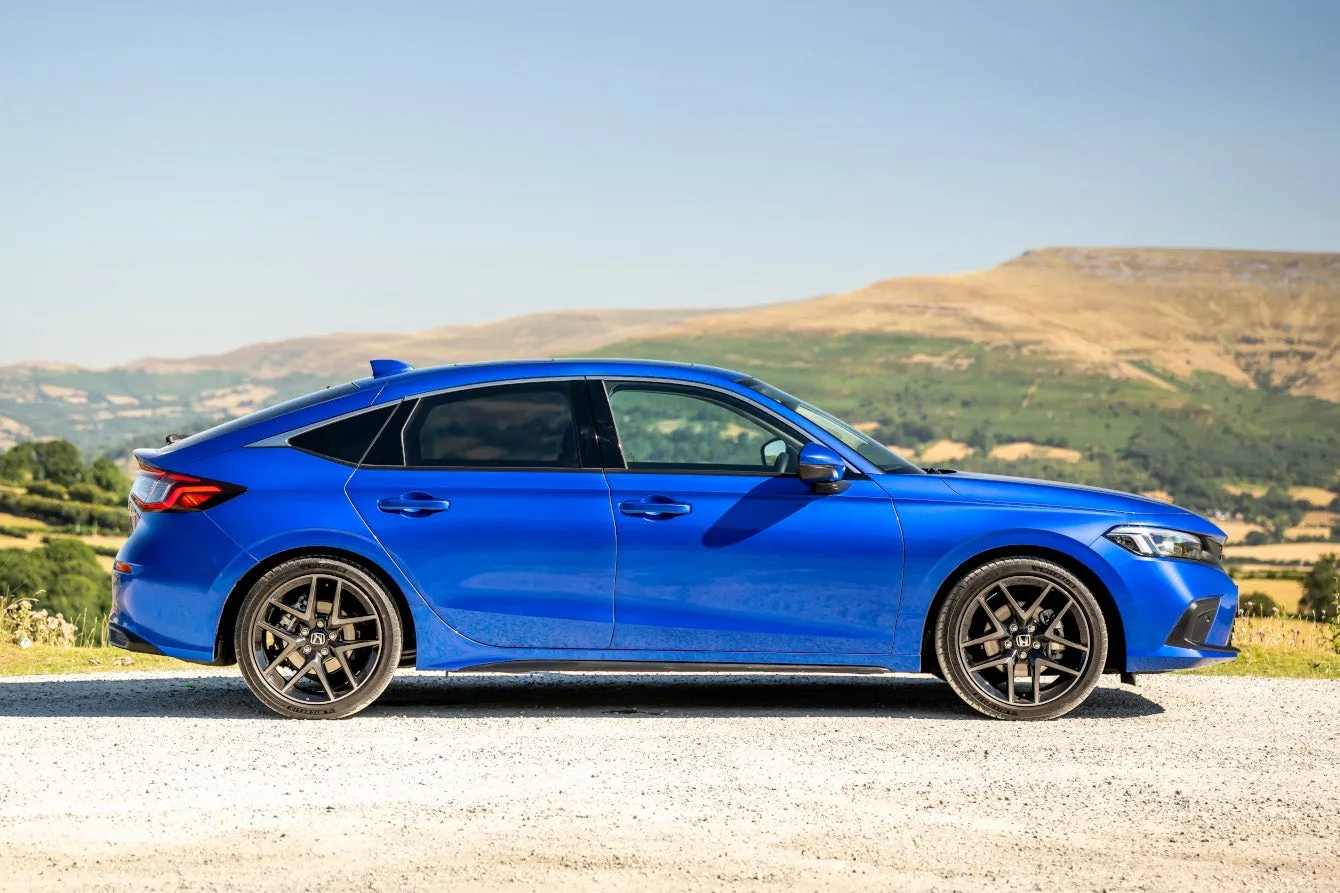
In combined-cycle WLTP tests, the Honda Civic returned 56.5mpg. Given the performance on offer, that's a very strong figure, up there with similarly powered diesels, and in our experience it's a pretty realistic figure as we managed just below that on a mixed test route with some spirited driving.
As it's a 'self-charging' hybrid rather than a plug-in hybrid, you don't have to do anything particularly arduous (like plugging it in) to see impressive fuel economy.
As there's no diesel engine available in the Honda Civic, you might wish to look elsewhere if you cover a lot of motorway miles. However, diesel is dropping in popularity generally, and there are fewer options left nowadays.
Honda Civic reliability and warranty
Honda generally performs well in terms of reliability, ranking highly in the annual HonestJohn.co.uk Satisfaction Index. In the latest 2024 edition, the Japanese brand finished fourth out of 33 carmakers in the manufacturer standings, and had two models (Jazz and CR-V) feature in the list of the top ten most reliable models, with the Civic itself featuring just outside in 14th.
Honda's warranty is slightly better than bog-standard, but not much, with three years or 90,000 miles worth of cover provided.
Honda Civic insurance groups and costs
Every version of the MK11 Honda Civic sits in insurance group 28, regardless of the trim level you go for. That's quite high for a car of this type: even the Toyota Corolla in its most expensive form is in group 21.
VED car tax: What is the annual road tax on a Honda Civic?
Gone are the days where the Civic's hybrid status earns you a small discount on your annual VED road tax. You pay the same flat rate of tax regardless of the type of fuel your car uses, and that rate currently stands at £195.
However, you need to be a bit careful, because the range-topping Advance trim now costs over £40,000 when brand new (it didn't always, but does now), and so can mid-range Sport versions if a few optional extras are added. This makes them liable for the luxury car surcharge, which adds a further £425 to your annual tax bill for a temporary five-year period between years two and six of the car's life. And you can't swerve this by buying used as the liability is inherited by subsequent owners. To be sure of exactly what you're looking at when buying used, we'd always recommend a quick Google search of the reg of any potential purchase.
Honda Civic price
"Because there is only one engine option - and it's an expensive hybrid one - the new Honda Civic isn't exactly a class bargain"
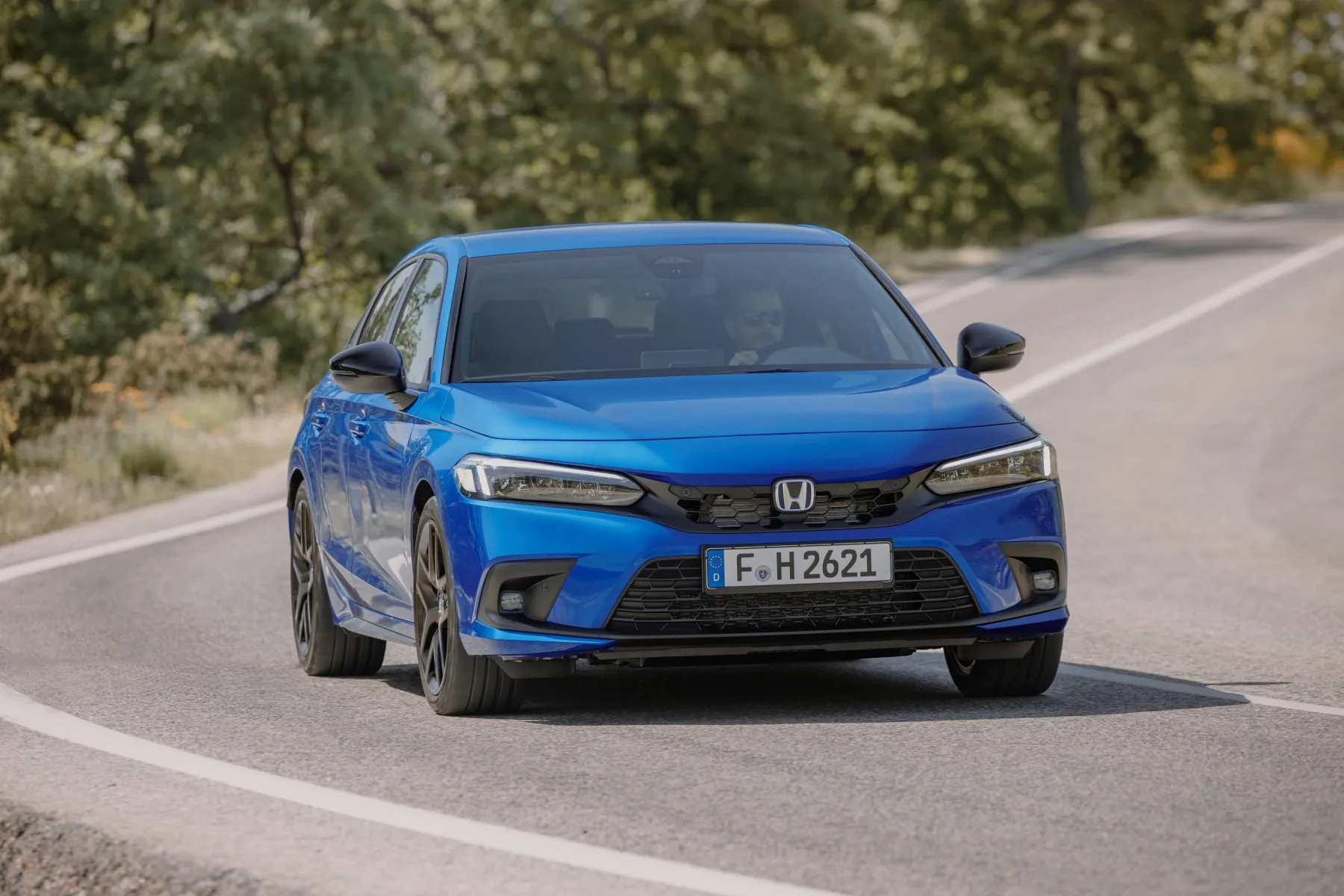
The latest Honda Civic starts at around £36,000, while specifying the Sport trim adds about £1,500 to the price, and Advance trim is almost £5,000 more than the base car. It's certainly not cheap for the family hatchback class, then, even compared with prestige offerings such as the Audi A3 or BMW 1 Series. The thing is, those rivals don't give you self-charging hybrid technology. A similarly powered version of the Toyota Corolla hybrid costs a similar amount, although it still a bit cheaper.
There are some good savings to be made on the used car market. The cheapest Mk11 Civics in our listings can be had for around £26,000. These are mainly Sport or Elegance models from 2022 or 2023, most with less than 10,000 miles on the clock.
Trim levels and standard equipment
The Honda Civic is available in three trim levels, all of which are pretty comprehensively kitted out. Certainly if you could only stretch to the base model, you wouldn't feel short changed.
The entry-level Honda Civic Elegance comes with 17-inch two-tone alloy wheels, LED headlights with auto high beam, sat-nav, heated front seats, front- and rear parking sensors, a rearview camera, dual-zone climate control, adaptive cruise control and the full roster of airbags and active safety kit.
Stepping up to the Honda Civic Sport gets you bigger 18-inch black alloy wheels, gloss black exterior trim, LED front fogs, part synthetic leather upholstery, a wireless phone charging pad, an auto dimming rear view mirror and rear air-con vents.
And finally, the top-spec Honda Civic Advance adds two-tone 18-inch alloys, a larger digital instrument display, electrically adjustable front seats, full leather upholstery, electric lumbar support for the front passenger, a heated steering wheel, a Bose premium sound system with 12 speakers, adaptive LED headlights and a panoramic glass sunroof.
Ask the heycar experts: common questions
Is the Honda Civic any good?
Do Honda Civics have problems?
Why is the new Honda Civic a hybrid only?
Get our latest advice, news and offers
Keep me updated by email with the latest advice, news and offers from heycar.
By submitting you agree to our privacy policy
